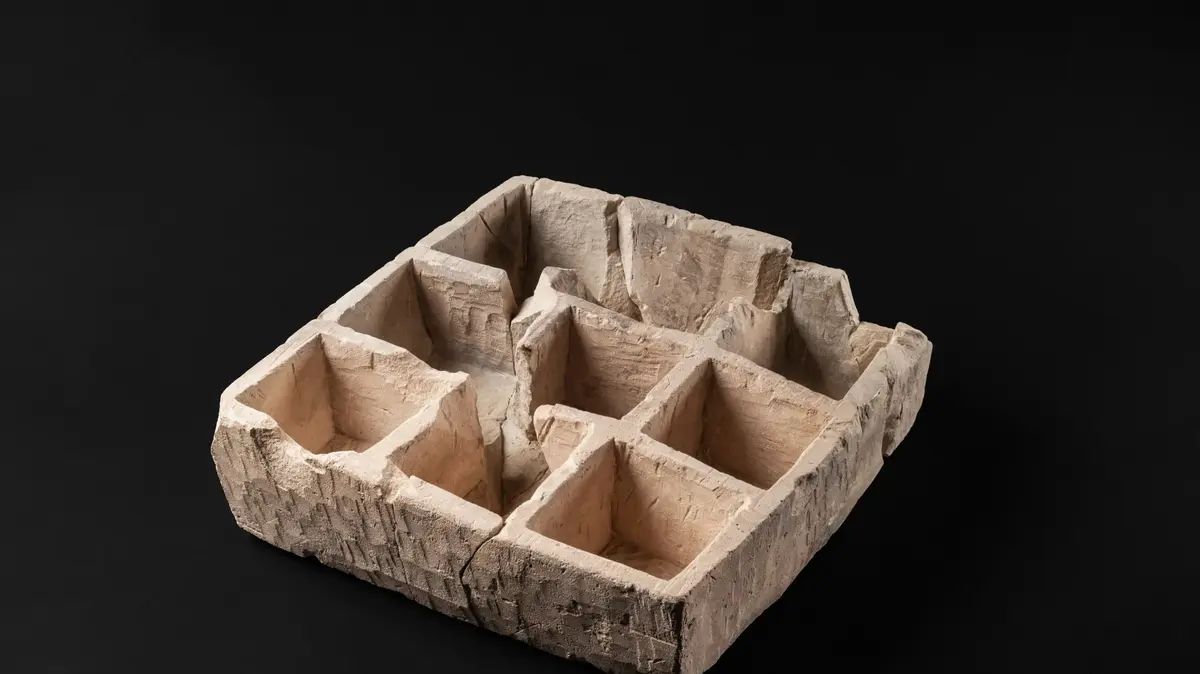Has the market of Jerusalem been discovered since the time of the Second Temple?/Photo: Amit Ben Atar, City of David Archives
A rare stone box with nine compartments, dating back to the days of the Second Temple - about 2,000 years ago, is now being revealed to the public for the first time in a display in the archeology wing of the Israel Museum.
The vessel, unusual in its design, was discovered in the excavations of the Antiquities Authority in the City of David in the National Park around the walls of Old Jerusalem, which are held with the funding of the Elad Association and in cooperation with the Ministry of Heritage.
The shape of the box is square, the size is 30x30 cm, and it is made of soft limestone (kerton) that is worked in a sculptor.
It is divided into nine square cells, similar in size and volume.
The sides of the object, which was discovered in excavations along the stepped street in the City of David in a layer of destruction from the end of the Second Temple period, are blackened, and it appears that it was burned during the events of the great rebellion that led to the destruction of Jerusalem.
The nine-compartment vessel was discovered in the remains of a building that stood next to the terraced street, and was used as a store.
An unusual tool in its design.
The box discovered in the excavations in the City of David/Antiquities Authority, Zohar Shemesh, Israel Museum
The size of the box is 30x30 cm, and it is made of soft limestone / Antiquities Authority, Israel Museum
What was the tool used for?
The researchers speculate that the vessel was used for commercial activity and for the presentation of goods in a small and measured quantity.
According to the managers of the excavation, Dr. Yuval Baruch and Ari Levy from the Antiquities Authority, "In the excavations of the terraced street, where the tray was discovered, many other objects were also found that testify to the lively commercial activity that took place along it.
Among other things, pottery and glassware storage vessels, mobile and stationary production facilities, cooking facilities, tools for measuring volumes, coins and many stone weights, of various values, were discovered, all testifying to the commercial activity of a lively urban market that operated along the street.
The street, which was the main street of the city 2000 years ago, was used by pilgrims and connected the Shiloh Pool to the Temple Mount.
It seems, then, that the vessel with the compartments is also related to the commercial activity that took place in the street."
The economic and commercial system that was conducted in Jerusalem during the Second Temple period was similar in nature to the one that occurred in the other cities of the Roman world. It was an economy that was based on the local production of consumer goods and their sale in the markets, along with imports of other products, some of them even exotic. Meanwhile, there were also special aspects to commerce in Jerusalem, which was conducted as a temple city. Many aspects of daily life and commerce were conducted in the light of the temple, and this is expressed, especially, in the extreme strictness of the city's residents and francia to the laws of impurity and purity. Because of this, the saying "a breach of purity in Israel" was established. Among the distinct archaeological finds that represent the phenomenon, stone tools stand out, thousands of which were discovered in excavations throughout the ancient city and its surroundings.
The reasons for using tools made of stone are halachic, and lie in the halachic recognition that stone, unlike tools made of Pottery and metal, does not accept impurity. Because of this, it was even possible to use the stone tools over time and in cycles. Adherence to the laws of impurity and purity.
Because of this, it can even be considered a distinct Jerusalem find," say Levy and Dr. Baruch.
The graded street in the city of David/Antiquities Authority, Emil Eljem
A box as shown in the archeology section of the Israel Museum/Antiquities Authority, Israel Museum
Fragments of a similar object were discovered about 50 years ago
But what was the tool with the cells used for?
Fragments of a similar object were discovered about 50 years ago by the archaeologist Nachman Avigad in the excavations of the Jewish Quarter, and were humorously called by him a "cracker bowl".
This nickname "sticks" to the object, and since then it is also used by some of the researchers dealing with the subject.
Since then, other fragments of this type of vessel have been discovered, all in Jerusalem, and especially in the excavations of the City of David, but the one recently discovered is the only complete example known to archaeological research.
And yet, at this stage of the research, the answer to the riddle of the object and what it was used for, still remains unanswered.
According to Dodi Mbaruch, a senior curator in the Israel Museum's Archeology Division, "The ark was found broken into many pieces with parts of it missing. The pieces were transferred to the Artifact Conservation Laboratory at the Israel Museum, where they were preserved and restored by Victor Uziel's hands - this is one of the specialties of our conservation laboratories, which know how to receive finds broken straight from the area and to move them from 'excavation mode to display mode.' We placed the box in our permanent display, together with a group of magnificent finds from Jerusalem's luxury houses from the end of the Second Temple - colorful wall hangings, chandeliers and magnificent vessels made of stoneware and metal - you are invited to come and see them ".
More on the same topic:
Archaeology

